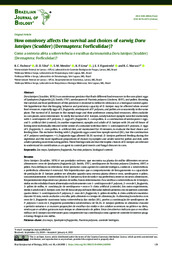How omnivory affects the survival and choices of earwig Doru luteipes (Scudder) (Dermaptera: Forficulidae)?
How omnivory affects the survival and choices of earwig Doru luteipes (Scudder) (Dermaptera: Forficulidae)?
Author(s): PACHECO, R. C.; SILVA, D. D. da; MENDES, S. M.; LIMA, K. P.; FIGUEIREDO, J. E. F.; MARUCCI, E, C.
Summary: Doru luteipes (Scudder, 1876) is an omnivorous predator that finds different food resources in the corn plant: eggs of Spodoptera frugiperda (J.E. Smith, 1797), uredospores of Puccinia polysora (Underw, 1897), and pollen. Knowing the survival and food preferences of this predator is essential to define its relevance as a biological control agent. We hypothesize that the foraging behavior and predatory capacity of D. luteipes may be affected when several food resources, especially eggs of S. frugiperda, uredospores of P. polysora, and pollen are concurrently in the same plant. The survival of D. luteipes in the nymph stage and their preference among food resources, often available in corn plants, were determined. To verify the survival of D. luteipes, newly hatched nymphs were fed exclusively with 1- uredospores of P. polysora, 2- eggs of S. frugiperda, 3- corn pollen, 4- a combination of uredospores + eggs, and 5- artificial diet (control). In another experiment, nymphs and adults of D. luteipes with 24 and 48 hours of fasting were individually released in the center of a container with four diets: 1- uredospores of P. polysora, 2- eggs of S. frugiperda, 3- corn pollen, 4- artificial diet, and maintained for 10 minutes, to evaluate the food choice and feeding time. The exclusive feeding with S. frugiperda eggs caused low nymph survival (8%), but the combination of P. polysora uredospores + S. frugiperda eggs allowed 58.3% survival. D. luteipes preferred feeding during the nighttime and the most significant proportions of choices by nymphs and adults were for pollen and diet, with adults spending more time eating pollen. These findings indicate that the trophic choices of D. luteipes are relevant to understand its contribution as an agent to control pest insects and fungal diseases in corn.
Publication year: 2021
Types of publication: Journal article
Unit: Embrapa Maize & Sorghum
Observation
Some of Embrapa's publications are published as ePub files. To read them, use or download one of the following free software options to your computer or mobile device. Android: Google Play Books; IOS: iBooks; Windows and Linux: Calibre.
Access other publications
Access the Agricultural Research Database (BDPA) to consult Embrapa's full library collection and records.
Visit Embrapa Bookstore to purchase books and other publications sold by Embrapa.

